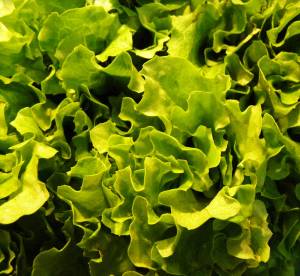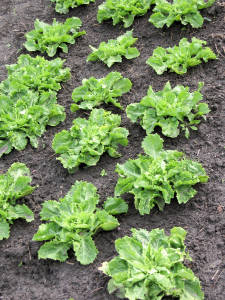Ah lettuce, the one element found in almost every salad the world over. It adds a wonderful crunchy texture to whatever it finds its way in to, which seems to be just about everything. On its own its bitter, watery taste is a bit off-putting but combined with other vegetables it’s wonderful.
Lettuce was probably first cultivated by the Egyptians. It is a hardy vegetable that grows easily, but becomes riddled with bugs and diseases without careful attention.
Varieties of Lettuce
There are a huge number of lettuces available, sorted in to different types. The Crisphead types have appropriately crispy leaves and are slow to mature. Iceberg lettuce falls in to this group. Cos lettuce has long upright leaves with a heart in the middle. Leaf lettuce have loose leaves and a small or no heart. They are the most hardy of all lettuce types. Coral lettuces are in this group.
Planting Lettuce
Lettuce likes soil temperatures less than 25°C, especially just after they have been planted. Therefore if the weather is at all warm you should sow in the evening. It is best to sow straight in to the ground as they do not transplant well. It’s perfect if temperatures will range between 10°C and 20°C during the growing season.
Lettuce enjoys a sunny plot with moisture retentive soil with a neutral pH. Ensure that the lettuce is allowed a bit of shade every now and then. Dry soil should be pre-treated with organic matter a month before sowing seed. Use a general fertilizer at a rate of 3 handfuls per square meter 10 days before sowing seed.
Sow seed sparsely in drills half an inch (1.5cm) deep. Be wary of not sowing too deep or else they will not germinate. They will need thinning as they grow. If the weather is cool and you’re careful, they can be transplanted to another pot when being thinned. The final spacing should be 8-12 inches (20-30cm) in between each plant and in between rows, depending on the size of the variety lettuce being grown.
Savvy gardeners will sow lettuce seeds at regular intervals throughout the season to have a constant crop. Sowing every fortnight is about right.
Growing Lettuce
Lettuce needs a lot of moisture, so water daily if the weather is warm and every second day if it is cool and dry. Water around the plants to avoid mildew. Provide about an inch of water per week. Weed regularly and carefully around the plant. As it loves moist soil, a thick layer of mulch will do lettuce good. It enjoys a good feed of a high-nitrogen fertilizer to promote growth. Lettuce that grows quickly tastes sweeter, so don’t be afraid to use a fertilizer to help things along.
Growing lettuce in containers is viable, especially for the smaller varieties with loose leaves. Sow seed in to as big a pot as you have available and keep it in the sunlight. Plants grown in pots require more water than those grown in the ground, so water daily to keep the soil moist. Aim for about 1.5 inches of water per week if growing in containers.
Harvesting Lettuce
Lettuce can be harvested at any time once leaves are formed. They must be harvested before bolting occurs (produce a flower stem to try and produce seeds) or else they will be very bitter.
Crispheads prefer to be harvested whole. Cut at the base with a sharp knife. Leaf lettuces can be harvested by the handful and left to grow more leaves. This perhaps makes them the best option for someone looking for a personal supply for salads. Some Cos lettuces can also be picked.
Lettuce likes to be picked as soon as it is mature. Most types of lettuce last for around a week in the refrigerator after picking.
Threats to Lettuce
Pests are by far the biggest annoyance with the otherwise easy-to-grow lettuce. Snails and slugs will be at it in no time, as will aphids, worms and mites. Use a pesticide or snail traps.
Lettuce burns in the sun quite easily if not adequately watered. Sometimes it will burn even if it is adequately watered. In this instance, provide some shade. The burning most often happens at the tips. Avoid watering directly on to the leaves in broad sunlight.
Fungal diseases are common, such as downy and powdery mildew, grey mold, leaf spot and blight. Fungicides can sometimes help, but prevention is much better. Prevent by planting seedlings shallowly (as described above), not over crowding and allowing good ventilation.
Bolting will happen if the temperatures are too warm (typically >21°C).
Viral diseases that affect lettuce include Lettuce Mosaic Virus, Lettuce Big Vein Virus and Lettuce Necrotic Yellow Virus. If you catch any plants with these diseases early in the piece, destroy them as soon as possible and try and control aphids as best as you can to prevent spread. None of the viruses prevent the plant from being edible, but they will stunt growth.



